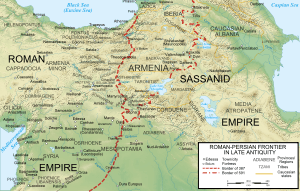Iberian War
| Iberian War | |||||||||
|---|---|---|---|---|---|---|---|---|---|
| Part of the Roman-Persian Wars | |||||||||
 The Roman-Persian frontier in the 4th to 7th centuries | |||||||||
| |||||||||
| Belligerents | |||||||||
|
Byzantine Empire, Iberia Ghassanids |
Sassanid Empire Lakhmids | ||||||||
| Commanders and leaders | |||||||||
|
Belisarius, Sittas, Gregory Hermogenes, Pharas, John of Lydia Sunicas Al-Harith ibn Jabalah Dorotheus |
Kavadh I, Perozes, Xerxes Azarethes Bawi Mihr-Mihroe Baresmanas † Pityaxes Al-Mundhir III ibn al-Nu'man | ||||||||
The Iberian War was fought from 526 to 532 between the Eastern Roman Empire and Sassanid Empire over the eastern Georgian kingdom of Iberia.
Origin
After the Anastasian War, a seven-year truce was agreed on, yet it lasted for nearly twenty years. Even during the war in 505, Emperor Anastasius I had already started fortifying Dara as a counter to the Persian fortress city of Nisibis for a looming conflict. In 524/525, the Persian shah Kavadh I (r. 488–531) proposed that Emperor Justin I adopt his son, Khosrau I; the priority of the Persian king was to secure the succession of Khosrau, whose position was threatened by rival brothers and the Mazdakite sect. The proposal was initially greeted with enthusiasm by the Roman Emperor and his nephew, Justinian, but Justin's quaestor, Proculus, opposed the move. Despite the breakdown of the negotiations, it was not until 530 that full-scale warfare on the main eastern frontier broke out. In the intervening years, the two sides preferred to wage war by proxy, through Arab allies in the south and Huns in the north.[2]
Tensions between the two powers were further heightened by the defection of the Iberian king Gourgen to the Romans. According to Procopius, Kavadh I tried to force the Christian Iberians to become Zoroastrians, who in 524/525 under the leadership of Gourgen rose in revolt against Persia, following the example of the neighboring Christian kingdom of Lazica. Gourgen received pledges by Justin I that he would defend Iberia; the Romans indeed recruited Huns from the north of the Caucasus to assist the Iberians.[3]
War
Violence escalated at various points where the power of the two empires met: in 525 a Roman fleet transported an Aksumite army to conquer Himyarite Yemen and in 525/526, Persia's Arab allies, the Lakhmids, raided Roman territories on the edge of the desert. By 526–527, overt fighting between the two empires had broken out in the Transcaucasus region and upper Mesopotamia, and the Persians continued to exert pressure on the Romans to obtain funds from them.[4] Following the emperor Justin I's death in 527, Justinian I succeeded to the imperial throne. The early years of war favored the Persians: by 527 the Iberian revolt had been crushed, a Roman offensive against Nisibis and Thebetha in that year was unsuccessful, and forces attempting to fortify Thannuris and Melabasa were prevented from doing so by Persian attacks.[5]
In 528, the Persians pressed on from Iberia to capture forts in eastern Lazica. Attempting to remedy the deficiencies revealed by these Persian successes, Justinian reorganised the eastern armies by dividing the command of the magister militum of the East in two and appointing a separate magister militum of Armenia over the northern portion.[6] The most important Roman initiative on the southern front in 528 was Belisarius's expeditions to Thannuris, where he tried unsuccessfully to protect Roman workers, undertaking the construction of a fort right on the frontier.[7] Damaging raids on Syria by the Lakhmids in 529 also encouraged Justinian to strengthen his own Arab allies, helping the Ghassanid leader Al-Harith ibn Jabalah turn a loose coalition into a coherent kingdom which was able to gain the upper hand against the Lakhmids over the following decades.
In 530, Belisarius led the Romans to victory over a much larger Persian force under Mihran through his superior generalship in the Battle of Dara, while Sittas and Dorotheus defeated a Persian army under Mihr-Mihroe at Satala. In 531, Belisarius was defeated by Persian and Lakhmid forces at the Battle of Callinicum, but, during the summer of the same year, the Romans captured some forts in Armenia, and effectively repulsed a Persian offensive.[8] The Roman failure at Callinicum was followed by a commission of inquiry, the result of which was the dismissal of Belisarius from his post.[9]
Truce
Justinian's envoy, Hermogenes, visited Kavadh immediately after the Battle of Callinicum to re-open negotiations but without success.[9] Justinian therefore took steps to bolster the Roman position, trying, at the same time, to engage Kavadh diplomatically. Kavadh died shortly afterwards, and in spring 532 new negotiations began between the Roman envoys and the new Persian king, Khosrau I, who needed to devote his attention to secure his own position. The two sides finally came to an agreement, and the Eternal Peace, which lasted less than eight years, was signed in September 532. Both sides agreed to return all occupied territories and the Romans to make a one-off payment of 110 centenaria (11,000 pounds of gold). The Romans recovered the Lazic forts, Iberia remained in Persian hands, but the Iberians who had left their country were allowed to remain in Roman territory or to return to their native land.[10]
See also
References
- 1 2 Barker 1966, p. 118.
- ↑ Greatrex & Lieu 2002, pp. 81–82.
- ↑ Greatrex & Lieu 2002, p. 82.
- ↑ Greatrex & Lieu 2002, p. 84.
- ↑ Greatrex & Lieu 2002, p. 85.
- ↑ Greatrex & Lieu 2002, p. 83.
- ↑ Greatrex & Lieu 2002, p. 86
- ↑ Greatrex & Lieu 2002, pp. 92–96.
- 1 2 Greatrex & Lieu 2002, p. 93.
- ↑ Greatrex & Lieu 2002, pp. 96–97.
Sources
- Barker, John W. (1966). Justinian and the Later Roman Empire. Madison: University of Wisconsin Press. ISBN 978-0-29-903944-8.
- Greatrex, Geoffrey; Lieu, Samuel N. C. (2002). "Justinian's First Persian War and the Eternal Peace". The Roman Eastern Frontier and the Persian Wars (Part II, 363–630 AD). New York and London: Routledge. pp. 82–97. ISBN 0-415-14687-9.